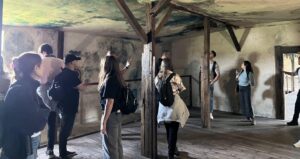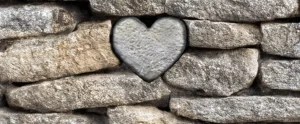Where did baptism come from?
A Jewish man called Yochanan was baptising people in the Jordan River in first century Israel, including his cousin who would later become world famous: Yeshua of Nazareth. Many Jewish people responded to the call of this Jewish man to immerse themselves in the river as a sign of repentance, and a desire to get right with God. Some of the Pharisees were also among them. Did Yochanan invent baptism at this time? Or was it part of Jewish tradition and practice before that?
No he didn’t, and yes it was.
And the Hebrew word for an immersion pool built for this purpose, “mikveh”, also points us in the right direction in understanding deeper meaning in the practice.
Immersion in Jewish Tradition
The Jewish laws which had been passed down orally from generation to generation had several things to say about the need for ritual washing, and the most desirable places to do it.[1] There are six different options suggested that satisfy the requirements, starting with pits or cisterns of standing water as acceptable but least desirable, moving up to pits that are refreshed by rainwater as slightly more desirable, then the custom-built ritual bath, or “mikveh” with 40 se’ahs (300 liters) or more of water, then fountains, then flowing waters.
But “living waters” (as found in natural lakes and rivers) which were considered to be the best possible situation.
The Mishnah specifies what makes the water clean or unclean, and expresses a preference for a larger, fresher body of water, “For in it persons may immerse themselves and immerse others”.
So Yochanan immersing people in the “Living waters” of the River Jordan was perfectly within Jewish law and practice at the time.
The Essenes, a strict Jewish sect, were doing it too out in the Judean Desert. But why were Jewish people immersing themselves in water? Is baptism in the Jewish Scriptures? Well, sort of, yes.
Ritual Bathing in the Bible
“Then the LORD spoke to Moses, saying: You shall also make a laver of bronze, with its base also of bronze, for washing. You shall put it between the tabernacle of meeting and the altar. And you shall put water in it, for Aaron and his sons shall wash their hands and their feet in water from it. When they go into the tabernacle of meeting, or when they come near the altar to minister, to burn an offering made by fire to the LORD, they shall wash with water, lest they die. So they shall wash their hands and their feet, lest they die. And it shall be a statute forever to them– to him and his descendants throughout their generations.” Exod 30:17-21
The priests had to be ritually clean (tahor) in order to serve at the tabernacle, and Israelites who had become ritually unclean (tamay) had to restore their situation with the passing of time and bathing their whole body in fresh, ritually clean (tahor) water, according to Leviticus 15.
Later, when the temple had been built, it was necessary for everyone to be immersed in a mikveh to become ritually clean before entering the temple. There are many ancient mikva’ot (plural of mikveh) to be seen in Jerusalem, and it is clear to see the two sets of steps for each one – a set of steps going down to the mikveh in an impure (tamay) state on one side, and on the other side, steps where the pilgrim will emerge fresh and ritually clean (tahor).
What did Jewish Baptism look like in the time of Jesus?
Following the upheaval of the 1967 war, archaeologists were presented with the opportunity to excavate parts of the upper city of Jerusalem, giving a new window into daily life in ancient times. Many of the houses were grand and spacious, with their own water cisterns and ritual baths in the basements.[2] Some houses were found to have had several of these mikva’ot, since it is thought that as well as providing for the household (which could even be up to fifty people) they would have been able to welcome and host pilgrims arriving for the Jewish feasts, catering for many more. Many of this upper city aristocracy were among the priestly class, who would have to stay in a state of ritual purity as much as possible, and so would have to immerse themselves in a mikveh frequently. Archaeologists also believe that the pools of Siloam and Bethsaida could have been used for ritual bathing in the Second Temple period for those visiting Jerusalem for the high holy days.
So immersion in a mikveh was quite common at the time of Yeshua, but the New Testament also describes baptisms taking place not only in rivers, but in any available body of water. In Acts 8, we read of a visiting pilgrim from Ethiopia, who came to believe in Yeshua as he read Isaiah on the way home:
“As they traveled along the road, they came to some water and the eunuch said, “Look, here is water. What can stand in the way of my being baptized?” (verse 36).
By this point baptism had come to signify a decision to accept Yeshua as Messiah and Lord.
The word “Mikveh”
The Hebrew noun for a ritual bath (mikveh) can help us understand a bit more about the Jewish notion of immersion. Often the Hebrew language reveals keys in the Hebrew thought behind the words. The word mikveh shares the same root as the word for hope (tikvah), for line (kav) and alignment, and the concept of hoping or waiting on God (kiviti l’Adonai).
Here is what Strong’s Lexicon has to say about the word:
מִקְוֶה miqveh, mik-veh’;
something waited for, i.e. confidence (objective or subjective);
also a collection, i.e. (of water) a pond, or (of men and horses) a caravan or drove:—
abiding, gathering together, hope, linen yarn, plenty (of water), pool.
and the same root word:
קָוָה qâvâh, kaw-vaw’;
to bind together (perhaps by twisting), i.e. collect; (figuratively) to expect:—gather (together), look, patiently, tarry, wait (for, on, upon).
The ideas of binding together, or twisting together, of yarn, gives us a good mental picture of what it means to align ourselves with God, and wait for him. We gather ourselves and bind ourselves to his word and to him, we line ourselves up with him, and wait for him in confidence and hope. When you read that the Psalmist says he waits upon the Lord, this is usually the word he is using.
The linked concepts of mikvah (collected pool of water) and tikvah (hope, confidence) are played out beautifully in Jeremiah 17:5-6, where the prophet poetically expresses the ideas through the metaphor of trees either rooted and flourishing beside water when we trust in God, or drying up for the lack of water when we put our trust in man. A few verses later, Jeremiah summarises:
Lord, you are the hope (mikveh) of Israel; all who forsake you will be ashamed (or dried out).
Those who turn away from you will be written in the dust because they have forsaken the Lord, the spring of living water.
This is a word play – the text actually says “The Lord is the MIKVEH of Israel, and all who forsake him will be ashamed or dried out!” So it makes more sense now that Jeremiah continues, to say that when we turn away from this mikveh of water and hope, we will be ashamed, which can also be translated “dried out”. Through this word play, Jeremiah deliberately points us back to the analogy of the man who trusts in God being like a tree beside plenty of water, and the one who leaves God ending up in dry, dusty shame.
A “Mikveh” of living water represents the bounty and resources of the new life that we can enjoy in God. Those who put their hope in God, choosing to align their lives with him, will never be dried out, but will always have fresh life in him.
Next time you see someone being immersed in water to signify their new life in Yeshua, the hope of Israel, the mikveh of Israel, call to mind all that he said about being the water of life, the well of living water that springs up to eternal life… because that’s exactly who He is!
[1] Tractate Mivaoth, Babylonian Talmud, Mishnah 1-8
There are six degrees of gatherings of water, each superior to the other.
The water of pits… The same rules apply to the water of pits, the water of cisterns, the water of ditches, the water of caverns, the water of rain drippings which have stopped, and mikwehs of less than forty se’ahs: they are all clean during the time of rain; when the rain has stopped those near to a city or to a road are unclean, and those distant remain clean until the majority of people pass [that way].
Superior to such [water] is the water of rain drippings which have not stopped.
Superior to such [water] is [the water of] the mikveh containing forty se’ahs, for in it persons may immerse themselves and immerse others.
Superior again is [the water of] a fountain whose own water is little but has been increased by a greater quantity of drawn water; it is equivalent to the mikveh inasmuch as it may render clean by standing water, and to an [ordinary] fountain in as much as one may immerse in it whatever the quantity of its contents.
Superior again are ‘smitten waters’ which can render clean even when flowing.
Superior again are ‘living waters’ which serve for the immersion of persons who have a running issue and for the sprinkling of lepers, and are valid for the preparation of the water of purification.
[2] Jerusalem Archeological Park / The Antiques Authority website: www.archpark.org.il
Levine Lee I., Jerusalem: Portrait of the City in the Second Temple Period (538 B.C.E. – 70 C.E.), Jewish Publication Society, 2002
Photo by Sime Basioli on Unsplash
















